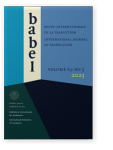Vol. 69:3 (2023) ► pp.375–397
Paratexts as a site of cultural reflection
James Legge and Wang Tao’s collaborative translation of The Chinese Classics
In the Ming and Qing dynasties the translation of Western books fueled the phenomenon known as Eastward Transmission of Western Sciences. In this context, the collaborative translation of The Chinese Classics by James Legge (1815–1897) and Wang Tao (1828–1897) was of particular significance because it promoted the transmission of Eastern learning to the West in the late Qing dynasty. This process of collaborative translation provided an opportunity for cultural interaction between China and the West; at the same time, it also generated competition between the two cultures. This paper sets out to investigate the paratexts written by the two co-translators, namely Legge and Wang, and aims to answer the following questions: How did the translation process of The Chinese Classics generate a dialectical interaction and why did it create a cultural struggle between the two translators? What impact did such a cultural collision exert on the translation and interpretation of The Chinese Classics and its reception in the West?
Article outline
- The translation of The Chinese Classics in the late Qing dynasty
- Wang Tao’s role as assistant translator
- Cultural collision between East and West in Legge’s translations
- Conclusion: The significance of the translation of The Chinese Classics in the history of the cultural exchanges between China and the West
- Notes
-
References
